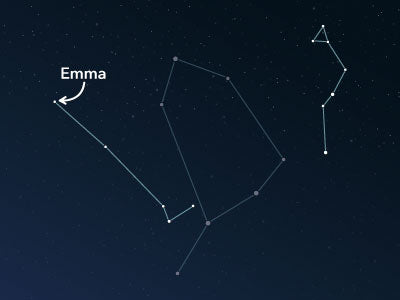The constellation Serpens
Characteristics
- Other names / Symbolism
- Snake
- Hemisphere
- Both Hemispheres
- Visibility
- June - August
- Area
- 637 deg²
- Brightest star
- Unukalhai (HIP number 77070)
- Specialties
- Open star cluster, globular clusters, gas nebula, ring galaxy

The constellation Serpens is an extraordinary constellation located along the celestial equator. It is one of the 48 constellations described by the Greek-Roman astronomer Claudius Ptolemy in ancient times and represents a snake in Greek mythology. There are several interesting deep-sky objects located within its area.
Hemisphere, visibility, and area
The Serpens constellation is visible in both hemispheres, showing up in all regions between latitudes 74° N and 65° S. In the northern hemisphere, it is visible even above the Arctic Circle, and in the southern hemisphere, it can be seen almost up to the southern polar circle, with the exception of Antarctica.
The best months to observe the constellation in the night sky are from May to August. Serpens covers an area of around 637 square degrees, making it the 23rd largest constellation. What makes it special is that it is the only constellation whose area consists of two unconnected sky areas.
It is made up of two long chains of stars separated by the constellation Ophiuchus. It is divided into the areas of Serpens Caput (Head) and Serpens Cauda (Tail). The head is always visualized as a striking triangle on star maps.
The brightest star in both areas is named Unukalhai (Latin: α Serpentis, Alpha Serpentis) or simply Unuk, which comes from the Arabic word for "the snake's neck." It is a triple star system about 70 light-years away, with an apparent magnitude of roughly 2.6.
As Serpens is divided into two sky areas, it has many neighbors. The Serpent's Head is adjacent to the two astrological constellations of Virgo and Libra. The Corona Borealis, the Boötes, and Hercules are also in close proximity.
The Serpent's Tail is adjacent to the constellations of the Scutum and the Aquila. The astrological constellation Sagittarius is also nearby.
Ophiuchus, which separates the two areas, is adjacent to both the Serpent's Head and the Serpent's Tail.
Specialties in the constellation
The Milky Way passes through the Serpens, providing some exciting objects such as open clusters, globular clusters, a gas nebula, and a ring galaxy.
The gas nebula, also known as the Eagle Nebula, is designated as M16 (Messier 16) and NGC 6611. It has an apparent magnitude of around 6 and is estimated to be 7,000 light-years away. The Hubble Space Telescope captured impressive images of the massive dust and gas clouds in the nebula. Observing this object requires a medium-sized telescope.

The ring galaxy PGC 54559, also known as Hoag's Object, is another remarkable sight. It is an unusual ring galaxy with a nearly perfect circle of young blue stars around an older yellow core. Its distance is estimated to be approximately 540 million light-years, and it was discovered by American astronomer Arthur Hoag in the mid-20th century.
Mythology
According to ancient mythology, the constellation represents the serpent that helped the physician Asclepius bring the dead to life. Asclepius observed how the snakes revived each other with herbs and applied this knowledge to the suffocated son of King Minos.
However, this displeased Hades, the god of the underworld, who asked his brother Zeus to end Asclepius' life. Zeus granted Hades' wish and had the physician killed by an arrow from a barbaric centaur.
To appease Asclepius' father, Apollo, Zeus placed Asclepius as a serpent bearer (Latin: Ophiuchus) along with the serpent in the sky.
Even today, the symbol of medicine is represented by the Rod of Asclepius, around which a serpent winds.
Constellation Visibility Tool
Los Angeles, USA
34.05°, -118.24°
Constellation Observing Guide
This guide shows when the constellation is visible above the horizon and provides the optimal viewing window when the sky is darkest. Times are displayed in your local timezone.Detecting timezone...
🎯 Best Observing Window
Optimal time when the constellation is fully visible AND the sky is at its darkest. Perfect for telescopic observations, astrophotography, and viewing faint details.
Optimal start
03:42
Aug 19, 03:42
Optimal end
07:45
Aug 19, 07:45
Duration
4.05h
Prime observing time
✨ Perfect Observing Conditions
This is the overlap when the constellation is above horizon AND the sky is at its darkest. Ideal for telescopic observations and photography.
Constellation Visibility from Your Location
6
Visible Stars
0
Never Rise
0
Always Up
100%
Visible
All stars of this constellation can be observed from your location
Constellation Visibility
When the constellation is above the horizon (includes daylight hours)
Rises
18:59
Aug 18
Fully Up
20:00 – 07:45
Aug 18
Starts Setting
07:45
Aug 19
Fully Set
08:45
Aug 19
Above Horizon Times
Includes daylight hours when stars aren't visible to naked eye.
Astronomical Night
When the sky is darkest (sun >18° below horizon)
Dark sky begins
03:42
Aug 19
Dark sky ends
12:22
Aug 19
Darkest Sky Period
Sun more than 18° below horizon. Best for faint objects.
Observing Tips
Read more interesting articles

An overview of all 88 constellations
Learn more about all 88 constellations and read interesting information about the mythology, visibility, and features.

Planetarium App
Discover the night sky with our planetarium app!
Available for iOS and Android.

Name a star in the constellation Serpens
Name a star in a constellation and create something that lasts for eternity.